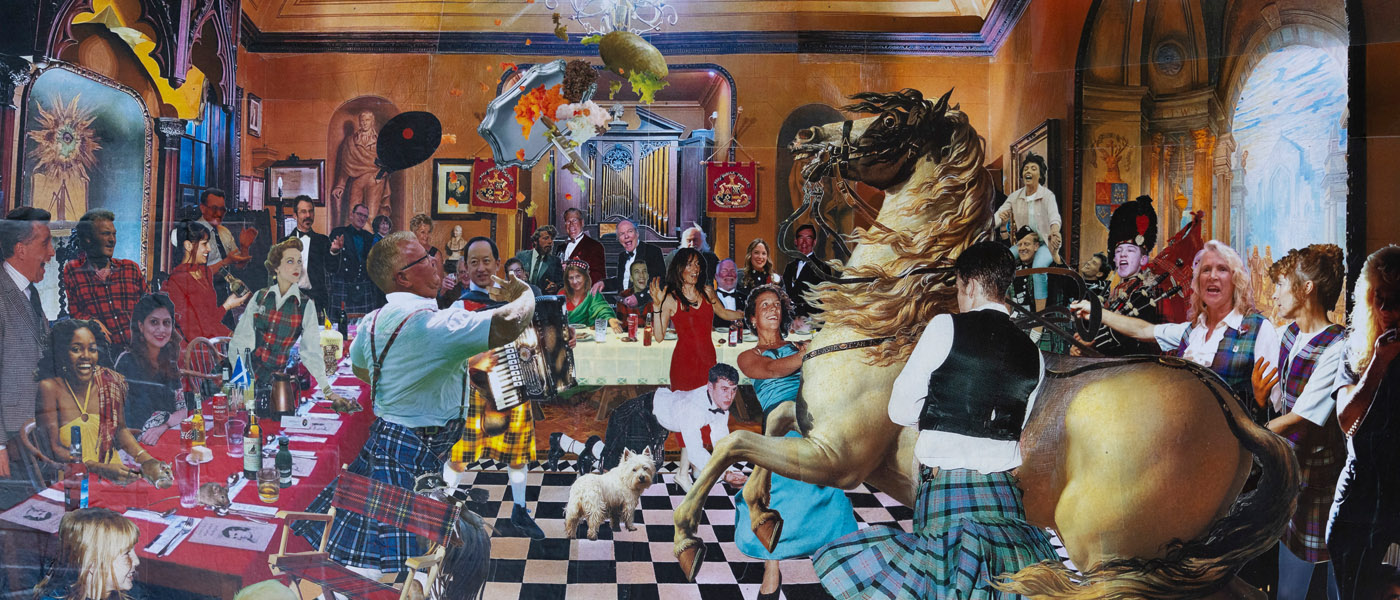New artwork celebrating Burns unveiled

A new piece of artwork by Scottish artist David Mach has been created for the University. It celebrates the global reach of Scotland’s national bard Robert Burns, and was officially launched in virtual reality on Burns Night (25 January).
The artwork, called ‘The Flying Haggis’, was commissioned by the University’s Centre for Robert Burns Studies to mark the end of a two-year project researching the history of Burns Suppers and mapping these events in the 21st century.
The artwork features some of the 350 images crowdsourced from people around the world who submitted photos of their own Burns Night events in 2021, many of which were held virtually due to the global pandemic.
“You’ll see ‘Flying Haggis' is not a stiff affair,” says David. “I wanted to make a Burns Night that Robert Burns himself would want to attend. It’s a collage but acts more like a film on pause. Press 'play' and the action will carry on. Even the room joins in the extravagance of the night. There’s an almost orgiastic celebration, Scottish to kick off but soon joining together all the liberal, freethinking, independent, romantic spirits of the world.”
The artwork was unveiled as the centrepiece of a virtual reality exhibition, created as part of a collaboration between the Centre for Robert Burns Studies and immersive learning platform Edify. As well as watching the official launch of the new artwork, members of the public were able to experience the story and legacy of the Burns Supper as never seen before, including a virtual trip to Alloway Auld Kirk as Burns imagined it in his poem ‘Tam o’ Shanter’.
The project has mapped more than 2,500 worldwide contemporary Burns Suppers across 140 countries on five continents and gives an inventory of their menus, settings, entertainments and orders of ceremony.
Professor Gerard Carruthers is co-director of the Centre for Robert Burns Studies and principal investigator on the History of the Burns Supper project: “Today, it is estimated that over nine and a half million people around the world take part in a Burns Supper every year. The Burns Supper is a huge testimony to the Bard’s enduring appeal, not only within Scotland but around the world. With the conclusion of our research, we believe we have now created a one-stop shop for everything you want to know about the Burns Supper, past and present.”
This article was first published March 2022.
Robert Burns
Born in 1759, Robert Burns’ poems and songs have been translated into every major language, and his influence has extended far beyond Scotland. Since the first Burns Supper was held in July 1801 by the Bard’s close friends as a memorial dinner, it has morphed into a worldwide event celebrating Scotland’s distinctive heritage and culture.
A Scottish Government-commissioned report published in January 2020 by the University’s Professor Murray Pittock shows that Robert Burns is worth over £200 million a year to the Scottish economy and the poet’s brand is worth nearly £140 million annually. The study also found that in Scotland alone, Burns Suppers are worth £11 million annually with an estimated 9.5 million people worldwide attending one each year.
The History of the Burns Supper project
The History of the Burns Supper project builds on the pioneering work of Dr Clark McGinn, an advisor on the project who did his PhD with the Centre for Robert Burns Studies at UofG.
The research project collated and tracked elements of the Burns Suppers from the first dinners, such as the Grace, the Immortal Memory and other kinds of poems, songs and speeches, to understand the patterns of growth over the last 221 years.
Poems and songs about Burns used over 200 years at these occasions were also gathered. Burns Suppers are detailed through the 19th century, across the British Empire, by missionaries, soldiers, reformers and others, across America, Asia, Australia and Europe and right up to the present day.
Through the generosity of Frank and Susan Shaw of Atlanta, the research project, which was launched in 2020, finished in January 2022.

